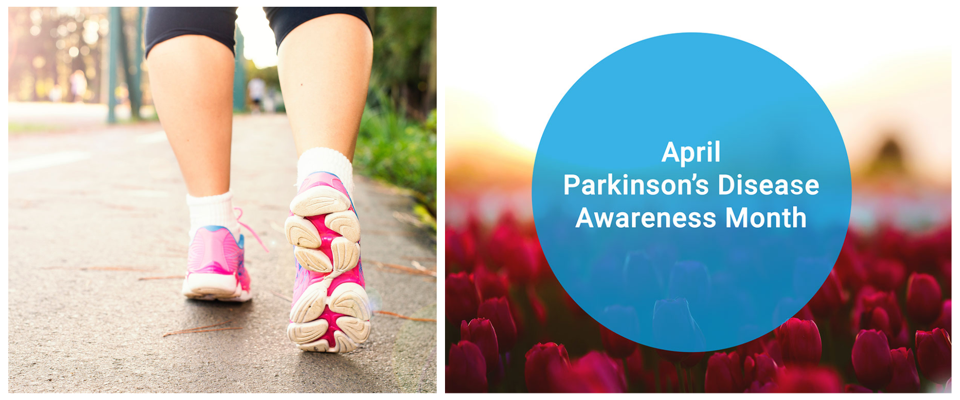You are here

Therapeutic Effects of Exercise for People Living with Parkinson’s Disease
AUTHOR: Dr. Kathleen Friel
PHOTOGRAPHERS: Daniel Reche, Tabitha Mort
April is Parkinson’s Disease Awareness Month
A diagnosis of Parkinson’s Disease can be quite challenging for patients and their families. Since April is Parkinson’s Disease Awareness Month, it’s a perfect time to highlight the importance of exercise in reducing symptoms and improving quality of life in people living with PD.
PD is caused by a loss of neurons in a part of the brain called the substantia nigra, which is located in the midbrain. The substantia nigra is important in the control of movement, and does so by signaling with other neurons via a neurotransmitter called dopamine. Loss of dopamine leads to movement difficulties, tremors, rigidity, impaired balance, and difficulty making spontaneous movements such as facial expressions. In people living with PD, levels of another neurotransmitter called norepinephrine are also low. This causes fatigue, along with impaired regulation of blood pressure and digestion. The severity of symptoms increases over time, but the speed and severity of progression is different for different people.
Treating Parkinson’s Disease
While PD is currently incurable, there are many treatment strategies that can improve a person’s impairments and quality of life. The most effective treatment involves restoring levels of dopamine and other neurotransmitters in the brain. This is typically achieved by medications, but some people eventually become resistant to these medications, or the medications cause serious side effects over time. Implantation of a stimulating electrode into the substantia nigra, called deep brain stimulation, is an invasive approach that can produce remarkable reduction in symptoms.
Despite the many therapies available for PD, people living with PD have impairments that cannot be fully ameliorated. Exercise is one adjuvant therapy that can reduce symptoms and improve quality of life. Although several studies have demonstrated benefits of exercise for people living with PD, more research is needed to determine which types of exercise and exercise schedules are best for which people.
Exercise and Parkinson’s Disease
Exercise has an effect on many body systems and functions, ranging from improved muscle strength to more restful nights’ sleep. For people living with PD, many of these effects have been studied, particularly examining functions that are impaired in people living with PD. Aerobic exercise, strength training, sport, and walking have all been shown to improve strength, balance, walking speed, and the time it takes for an individual to get up from a seated position and move about a room.
Exercise can even affect cognitive function. A recent study showed that in people living with PD, better cardiorespiratory fitness is positively associated with better executive function and memory. Physical exercise promotes the release of brain-derived neurotrophic factor (BDNF), which can encourage neuroplasticity and strengthen circuits used for executive functioning and memory.
It is unclear how often and intensively people living with PD should exercise to achieve optimal benefits. Ideally, a person would follow the standard recommendation of 150 min of moderate exercise per week or 75 min of vigorous exercise per week.
Dance and Tai Chi
For people living with PD, exercise can be a challenge – a challenge to find a welcoming gym or fitness center, and to find exercises that do not cause pain. Two particularly successful forms of exercise for people living with PD are dance and tai chi. Both of these activities involve focused, deliberate movement, and have repetition or melodies that likely assist people in movement flow. Dance for PD® is a program in Brooklyn, NY (and zoom!) that has been studied extensively. Weekly dance classes can improve balance, cognitive function, strength, mood, and quality of life.
Tai chi is another well-studied exercise program that can improve symptoms of PD and quality of life. People living with PD who practiced tai chi regularly have a reduced incidence of falls than people who do not practice. Similarly, yoga has been shown to improve quality of life in people living with PD. There is a wide range of responsiveness to any exercise regimen. The most promising predictor of how much people’s health improve with exercise is sticking with exercise. Even walking for 20 minutes per day can have an impact! People living with PD should consult with their doctor when starting an exercise program.
Go for a Walk for PD
Although deeper research is needed to optimize exercise regimens for people living with PD, we do know that exercise has a variety of benefits. During April, which is Parkinson’s Disease Awareness Month, whether you have PD or not, take some time to go for a walk or do other outdoor exercise. The weather is amazing!

